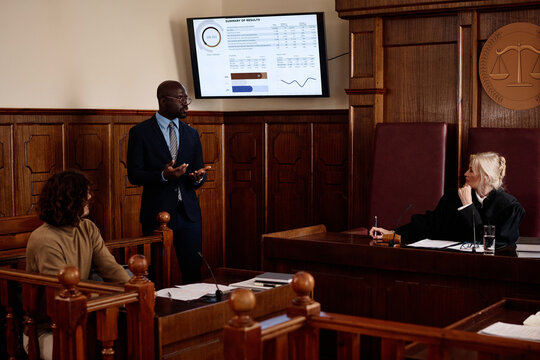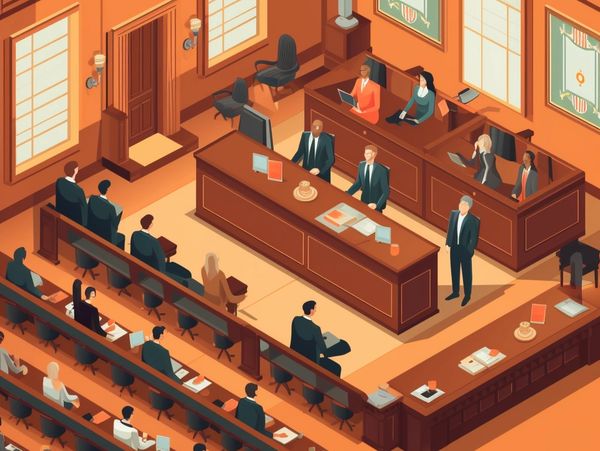Navigating the Complexities of Test Presentations: Tips for Seamless Shipment and Compelling Arguments
In the realm of lawful process, the art of test discussion stands as a critical determinant of success. The intricacies intrinsic in test presentations need a fragile balance of ability, strategy, and finesse.

Understanding Test Objectives
To effectively navigate a trial, it is crucial to have a clear understanding of the purposes that require to be attained. Prior to stepping right into the court, lawful groups have to specify their goals and desired outcomes. These purposes work as guiding principles throughout the trial, shaping techniques and influencing decision-making processes.
Understanding test purposes entails an extensive evaluation of the case, legal criteria, and the customer's benefits. Trial Presentations. It requires a careful exam of the realities, recognizing essential issues, and expecting potential difficulties. By establishing quantifiable and particular objectives, attorneys can customize their arguments and discussions to align with the preferred results
In addition, a clear grip of trial objectives makes it possible for legal teams to focus on evidence, witnesses, and legal arguments successfully. It permits the development of a meaningful story that resonates with the discretionary, reinforcing the general situation presentation.

Organizing Evidence Successfully
Having a clear understanding of test goals lays the foundation for arranging evidence effectively in lawful proceedings. By lining up the discussion of evidence with the wanted results of the test, lawful groups can enhance their arguments and boost their persuasiveness.
Another key aspect in organizing evidence properly is establishing a sensible flow. Offering proof in a sequential and systematic fashion can help construct an engaging story that supports the legal arguments being made. In addition, utilizing visual aids such as charts, timelines, or graphes can further enhance the company of proof and aid in clarifying complicated connections or series of occasions.
Furthermore, making certain that all evidence presented is acceptable and appropriate to the situation is crucial. Unnecessary or inadmissible evidence can detract from the strength of the disagreement and possibly harm the credibility of the presenting party. A meticulous review and selection procedure should be carried out to include just the most legitimately sound and impactful proof in the test presentation.
Crafting Influential Stories
Crafting compelling narratives plays a crucial function in offering influential disagreements throughout legal proceedings. A well-crafted narrative has the power to mesmerize the target market, evoke feelings, and eventually persuade the choice for today event. When creating a narrative for a trial presentation, it is crucial to develop a clear story that highlights bottom lines and links them in a meaningful way. Begin by outlining the truths of the situation in a compelling fashion, making sure that the sequence of events is very easy to follow. Introduce personalities successfully, supplying background details that helps the audience understand their inspirations and actions. Furthermore, including dazzling descriptions and interesting language can bring the narrative to life, making it more remarkable for the court and jury. By weaving Discover More Here with each other proof, testimony, and legal disagreements into a persuasive and natural narrative, lawful specialists can efficiently support for their customers and raise the chance of a positive end result in the court.
Grasping Visual Help
Effective use of aesthetic help is essential to enhancing the influence and quality of trial presentations. Visual help, when utilized strategically, have the power to streamline complex details, strengthen key factors, and leave a lasting impression on the judge and jury. To master visual aids in test discussions, it is crucial to make sure that they are clear, succinct, and appropriate to the disagreements being made.
When incorporating visual aids, such as graphes, photos, timelines, or graphs, right into a test discussion, it is necessary to keep them visually appealing yet expert. The visuals ought to complement the spoken debates, giving an aesthetic representation of the information being talked about without frustrating the audience with unneeded information.
Additionally, exercising with the visual help in advance is vital to make certain a smooth distribution during the test. Familiarizing oneself with the web content, changes, and timings of each visual aid can aid keep the circulation of the discussion and avoid technological glitches that might occur.
Providing Impactful Closing Disagreements
An engaging closing disagreement offers as the culmination of a trial discussion, enveloping the core narrative and encouraging the judge and jury towards a desirable decision. Begin by outlining the main debates that support your customer's setting, stressing why the evidence provided throughout the trial supports your story.
Furthermore, including sob story can even more strengthen your closing debate. By humanizing the case and linking on an individual level with the decision-makers, you can evoke empathy and understanding, influencing their assumption of the truths offered. Additionally, reiterating the lawful standards that need to be fulfilled for a beneficial ruling can reinforce the credibility of your setting. Inevitably, have a peek here a well-crafted closing argument should leave an enduring impact, engaging the court and court to rule in your customer's support.
Verdict
In verdict, understanding trial discussions entails recognizing goals, arranging evidence, crafting stories, using aesthetic help, and supplying impactful closing disagreements. By implementing these strategies successfully, lawyers can present their case seamlessly and make engaging disagreements in the court room. It is vital to browse the intricacies of trial discussions with Web Site precision and ability to attain success in legal process.
By aligning the presentation of proof with the desired end results of the trial, lawful teams can strengthen their arguments and boost their persuasiveness (Trial Presentations). To understand visual help in test discussions, it is crucial to make sure that they are clear, succinct, and relevant to the arguments being made
An engaging closing debate offers as the end result of a trial discussion, encapsulating the core narrative and encouraging the court and jury in the direction of a desirable choice. Begin by outlining the primary disagreements that sustain your client's position, emphasizing why the proof offered throughout the test sustains your narrative.In final thought, understanding test presentations involves recognizing goals, organizing proof, crafting stories, utilizing aesthetic help, and providing impactful closing debates.